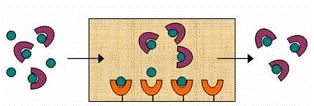Department of Chemistry
Document Type
Article
Date of this Version
12-21-2012
Citation
Published in final edited form as: J Chromatogr A. 2012 December 21; 1269: 198–207. doi:10.1016/j.chroma.2012.09.009. Version presented here is from NIH PubMed Central.
Abstract
Various organic-based monoliths were prepared and optimized for immobilization of the protein human serum albumin (HSA) as a binding agent for chiral separations and high-performance affinity chromatography. These monoliths contained co-polymers based on glycidyl methacrylate (GMA) and ethylene glycol dimethacrylate (EDMA) or GMA and trimethylolpropane trimethacrylate (TRIM). A mixture of cyclohexanol and 1-dodecanol was used as the porogen, with the ratio of these solvents being varied along with the polymerization temperature to generate a library of monoliths. These monoliths were used with both the Schiff base and epoxy immobilization methods and measured for their final content of HSA. Monoliths showing the highest protein content were further evaluated in chromatographic studies using R/S-warfarin and D/L-tryptophan as model chiral solutes. A 2.6–2.7-fold increase in HSA content was obtained in the final monoliths when compared to similar HSA monoliths prepared according to the literature. The increased protein content made it possible for the new monoliths to provide higher retention and/or two-fold faster separations for the tested solutes when using 4.6 mm i.d. × 50 mm columns. These monoliths were also used to create 4.6 mm i.d. × 10 mm HSA microcolumns that could separate the same chiral solutes in only 1.5–6.0 min. The approaches used in this study could be extended to the separation of other chiral solutes and to the optimization of organic monoliths for use with additional proteins as binding agents.



Comments
Copyright Elsevier Inc. Used By Permission.